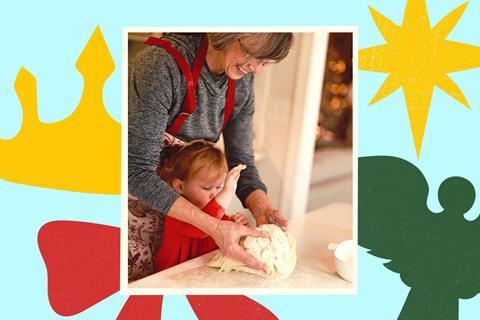When I was a child, Christmas was a very special time for me. Yes, I was excited about the presents - I was one of those children who was awake at 4am. My parents said that I wasn’t allowed to get up before 7, and those three hours were the longest of the year…

But there was something more about the season than my own rampant commercialism. There was something sacred about Christmas that was different from the rest of the year.
There was something ‘other’ about the tradition, the songs, the candlelight. There was something that helped me draw closer to God at this time of year than at any other. I don’t know whether my parents intentionally put things in place to foster this yearly encounter, but if they did, they certainly helped me meet with God face to face.
Christmas is full of spiritual ‘triggers’ that can help children focus on this great story and process what is going on around them. But in already busy lives, how can we help children and young people meet with God when their heads are already full of parties, presents and pudding?

Get an Advent calendar
This might be stating the obvious, but an Advent calendar is a great place to start exploring the Christmas story intentionally. But there is an elephant in the room, and elephant, thy name is chocolate. Children and young people, for some reason, aren’t that interested in an Advent calendar that doesn’t have a sweet treat every day.
You could solve this by having two calendars, one chocolate and one more focused on the Bible story, or you could get hold of a calendar from the Meaningful Chocolate Company. These Advent calendars combine chocolate with the Christmas story, providing a line from the story alongside a sweet treat each day.
Alternatively, combine a chocolate calendar with a list of readings from the Bible that tell a little bit of the story every day. A few years ago our faith at home expert, Victoria Beech, created a list available on the GodVenture website (together with lots of other Advent resources) to help you, or you can put together a list of 24 or 25 verses yourself.
Becky May, regular contributor to this magazine, has a Jesse Tree as part of her family’s Christmas faith development. The Jesse Tree is a medieval tradition, drawing its name from the fact that Jesus comes from David’s (and so his father Jesse’s) family (Isaiah 11:1-4). 24 or 25 different decorations are put on the tree, each one representing part of the Christmas story (or broader narrative of the Bible).
Whatever the make-up of your Advent Calendar or tree, try to open the doors at the same time each day. You don’t need to spend ages on this, simply carve out a regular five minutes during your hectic day to reflect on the story behind the celebration. Waiting until everyone is together to eat their chocolate will help you think about family and consider others, as well as exploring the story together.

Play with the story
Having a nativity set as part of your Christmas decorations can provide a focal point for faith development. Louisa Berry lives in Northamptonshire with her two children. When they get their nativity set out, it offers her children the chance to play and interact with the story.
“We set up the nativity scene and tell them the story. My daughter will re-enact it with all the models, often with her own embellishments to the story! When she was younger, she was obsessed with babies crying and she spent ages rocking the nativity set baby Jesus to sleep! As she played with the set, she would introduce other items and figures to the story. Some of them would even end up in the manger!”
This playing with and around the story is an element of children’s ministry approaches such as Godly Play. Godly Play describes itself as a practice which “puts the teacher in the role of spiritual supporter or guide who fully accepts that each child has his or her own relationship with God already.”
Using a simple nativity set to help children to explore the Christmas story fosters this relationship with God.
Maggie Barfield is a children’s ministry specialist working with Scripture Union. Her children are adults now, but she still continues with a tradition she started when they were young: “We had nativity characters scattered around the house, gradually moving towards a place designated as Bethlehem.
As we moved the pieces, we told the relevant part of the story, over several days before and after Christmas.
“Over time, it evolved into the pieces ‘spontaneously’ moving and family members commenting: ‘Where have the wise men got to? How did they get on top of the picture frame?’ Now, when my grown-up children visit, the nativity pieces are still scattered around the house and they still get moved and commented on.
No one ever sees them move or admits they may have had anything to do with it. If I didn’t put them out, there would be comments and complaints!”
Read the Bible
Joy Dilnot has three sons aged 15 to 22. She and her husband have tried a few things over the years to help her children engage with the story of Christmas.
Some things have worked, some haven’t. One thing that has stuck is that, on Christmas morning, she gathers the family together to read the Bible: “We always read the Bible on Christmas morning together, the story of the birth of Jesus, and we pray together for those loved, lost and less fortunate. Sometimes it’s difficult to get the teenagers out of bed, but we always do, as it means that we focus on faith at the start of the day.”
Go to church
There are so many special services and events that take place at Christmas, so consider taking your family to one or more of those. The obvious choice would be to attend services that are geared to children and / or young people – these services will help your children engage with the story of their level, and then you can chat about what everyone in the family has discovered – on the journey home, over a meal or when you’re out and about.
But why not choose a service which you wouldn’t normally go to – perhaps at a cathedral or other big church? This will give children and young people a different perspective on Christmas, one that isn’t overfamiliar. Where can you go that will help you see the story through new eyes?

Light a candle (or two)
Whatever the time of year, candle can be a focus for concentration and provide space for a child or young person to think more about their own relationship with Jesus. In Advent and Christmas, there are plenty of opportunities to do that. You can use an Advent candle, a candle which is marked with 24 sections.
Every day, you light the candle and burn it down to the next day’s marker. Like the Advent calendar, light the candle at the same time every day, and let all the members of the family have a turn a lighting it (under supervision!). You could combine this with the start of John’s Gospel, to give a different take on the Christmas story.
An Advent crown is an ideal thing to draw the family around, and to focus your thoughts on the different parts of the story. Many churches use them, but you can make one to use at home. A quick internet search will bring up sets of instructions you can follow, including that Blue Peter one you might remember from your own childhood!
We have one on our NexGenPro website. If you don’t know what the different candles symbolise, then your search should provide you with that information too. This will be a weekly activity, rather than a daily one, so you might be able to spend a little more time thinking about Jesus coming into the world and what that means to you.
Give to others
Joy Dilnot has tried a quite few things to get her teenage children to engage with the story. Some have stuck, some haven’t, but that illustrates a good point – you have to try things out and see what works. It doesn’t matter if something isn’t successful, simply try something else next year. One thing that has proved a success for Joy and her family is matching giving and mission.
“Pre-pandemic, the two older boys came with me on a mission trip and seen social action and mission work first-hand. So, now at Christmas we all donate some of our money to charity (usually ‘buying’ something specific like a cow or toilet twinning). This is then put on the tree so that everyone can see it.”

Make and bake at Christmas
Food plays a big part at Christmas and you can enjoy making and baking together. Using Bake through the Bible at Christmas (Susie Bentley-Taylor and Bekah Moore), will help you explore the Bible story through baking and making food. Moreover, baking or making food provides a good time to chat – when hands are busy, that’s often the best time to talk about faith, regardless of the age of your children. Why not try Christmassy treats such as gingerbread, or decorating cupcakes or cake pops?
If you have children who enjoy craft, then Flame Creative Children’s Ministry is a good place to go for some great ideas that will help you focus on the Christmas story and engage your children in conversations that will help build their faith, and yours!
Scale it appropriately
Christmas is a time when everything seems different, and if you’ve got children with additional needs, all this ‘different’ might be too much to cope with. Adding in a faith-building time too could prove a step too far.
Ruth Thomas has two children, one of whom is autistic: “The main thing with autism (or other special needs come to that) is to do what suits your family and ignore what others think you ‘should’ do.
If your child can’t cope with Christmas trees, wrapping paper, decorations, gifts, parties, crackers or fancy food, none of those things is essential to Christmas so just drop any or all of them. Do tell the real story of course, and do go to church if possible, but even that isn’t compulsory.”
Slotting exploration of the Christmas story into your regular routine is a good place to start. You will know what time in the day would be best for your child(ren) and what you can swap out of your schedule.
Make it achievable
Whatever you decide to try, it needs to be achievable. While you might win Instagram / Pinterest likes or repins by doing something incredible and labour intensive, you will probably also be stressed, tired and utterly fed up of Christmas before it has arrived.
Choose something that you can fit into your schedule, that your children or young people can take part in and that gives them the tools to reflect on the Christmas story.
What becomes clear through all of these examples is that, if you start something simple and early in your family’s life, then you will be able to create traditions that your children will want to continue throughout their teenage life and into adulthood. And these traditions can form the framework within which faith can develop and grow.
If you already help your children grow in faith at Christmas, why not share with us what you do on Twitter or Facebook? Or email us your ideas and we’ll share them with the rest of the Premier Youth and Children’s Work readership!

































